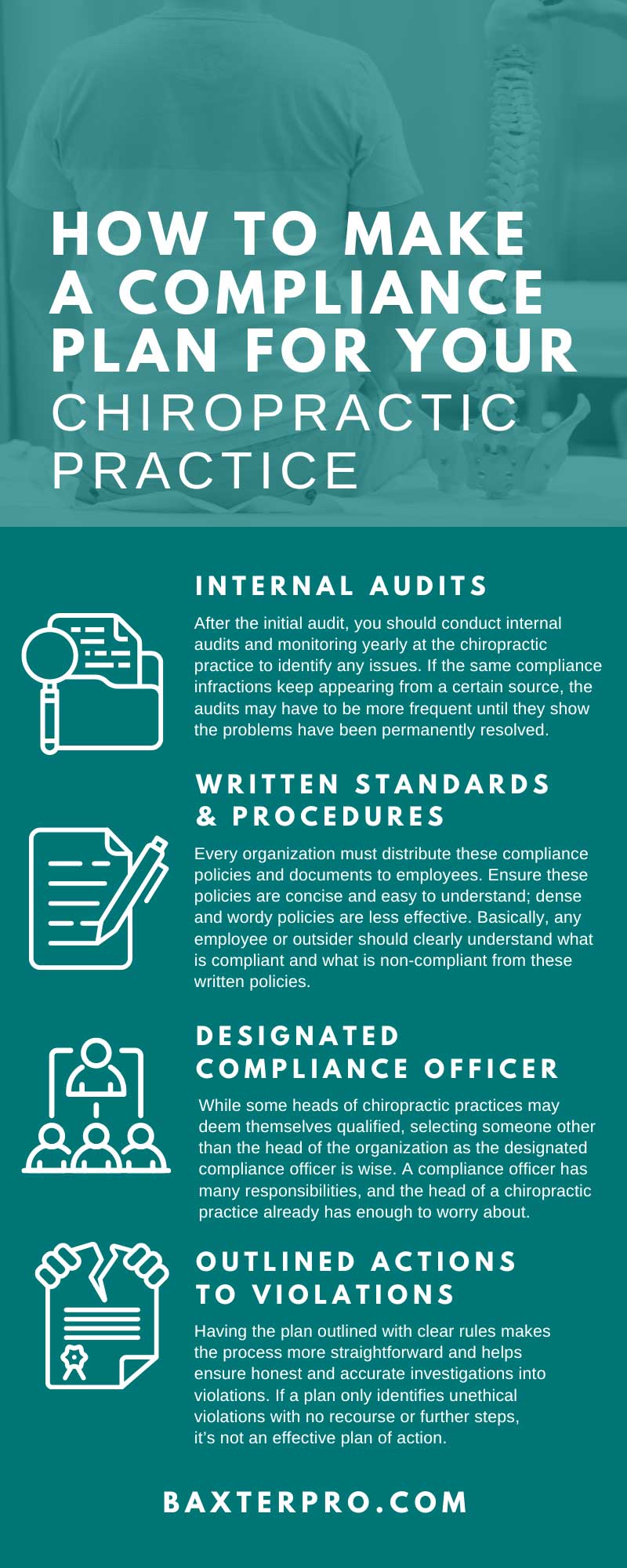
How To Make a Compliance Plan for Your Chiropractic Practice
Jan 05 2023Does your chiropractic practice have a clear and thorough compliance program? If not, we’ll show you the basics of a compliance plan and how to make one for your chiropractic practice.
What Is a Chiropractic Compliance Plan?
First, what is a chiropractic compliance plan? A compliance plan is a formalized system of procedures and policies that help an organization or practice prevent, detect, and resolve conduct that government bodies and healthcare organizations have deemed unethical and illegal.
Basically, it’s a plan to keep an organization honest by holding itself and its employees accountable for unethical practices like fraud, waste, and abuse. Most healthcare providers are required to have a compliance program in place. However, even if your chiropractic practice isn’t legally required to have one, it is highly recommended that any practice that deals with insurance billing have a program in place.
Why Does My Practice Need a Compliance Program?
If you’re a chiropractic practice that isn’t legally mandated to have a compliance program, why should you have one? Why go through all the trouble?
Prevent Unethical Conduct
The principal motivation for an organization’s stringent and clear compliance program is to deter, detect, and resolve unethical practices. Unfortunately, unethical practices like fraud and abuse are rife in healthcare, especially with insurance billing.
But with an effective compliance program in place, practices can detect unethical conduct before it worsens and spreads, resolving it for the betterment of all parties. Simply put, a compliance program is the best way for a practice to ensure its employees behave honestly and reliably.
Shield Organization From Sanctions
When a healthcare provider like a chiropractic practice comes under scrutiny in the form of a records request or investigation, one of the first things authorities will examine is the compliance program. With a clear and useful compliance plan, a practice has a stronger defense against accusations of organizational wrongdoing.
Let’s say a legal authority finds an effective compliance plan at a practice where an employee committed insurance fraud. In this case, the authority is more likely to be lenient with discipline and isolate sanctions against the individual instead of the organization. So for a pure self-preservation motive, a compliance plan is integral to any chiropractic practice.
Establish Credibility
A compliance program helps create a more ethical and honest working environment for a chiropractic practice. This makes it a more credible organization in the eyes of peers, authorities, and partners such as insurance agencies. Credibility is essential for a practice to survive in an industry like healthcare, as your practice has a tremendous responsibility to patients and other healthcare organizations.
Furthermore, a compliance plan is helpful when finding chiropractic liability insurance. Insurance providers want to assume the least risk possible, so an enforced compliance plan bodes well for them.
What Your Chiropractic Practice’s Compliance Plan Needs
Now that you know why a compliance plan is important, we’ll explain what every chiropractic practice compliance plan needs and how you can make one for your practice.
Internal Audits
The first step in a compliance program is an internal audit to show that the chiropractic practice is identifying and improving compliance from within. It’s wise to start with an Office of Inspector General (OIG) compliance manual and review the work plan that helps organizations identify areas of concern.
After the initial audit, you should conduct internal audits and monitoring yearly at the chiropractic practice to identify any issues. If the same compliance infractions keep appearing from a certain source, the audits may have to be more frequent until they show the problems have been permanently resolved.
For the initial internal audit, consider hiring a compliance consultant who can provide professional expertise and show the organization the proper way of doing things.
Written Standards & Procedures
Once the initial audit is complete, the chiropractic practice will receive a report card that identifies areas of risk in the organization. To address these areas of risk, the head of the chiropractic practice and the compliance officer or committee will update the written policies and procedures of the practice.
Every organization must distribute these compliance policies and documents to employees. Ensure these policies are concise and easy to understand; dense and wordy policies are less effective. Basically, any employee or outsider should clearly understand what is compliant and what is non-compliant from these written policies.
Designated Compliance Officer
While some heads of chiropractic practices may deem themselves qualified, selecting someone other than the head of the organization as the designated compliance officer is wise. A compliance officer has many responsibilities, and the head of a chiropractic practice already has enough to worry about.
Some practices select a compliance committee to divvy the responsibilities among multiple people. For example, one person conducts internal audits, and another implements a training program.
You may also choose to hire an outsider as a compliance officer rather than hire within the company. This may provide added impartiality.
Employee Compliance Training & Education
Obviously, for a compliance plan to be effective, all employees must know and learn about the program. Every new hire should receive compliance training, and all current employees should undergo compliance reviews yearly.
It’s also wise to have focused compliance training for specific departments and roles, as different areas of the practice may differ in compliance requirements.
Outlined Actions to Violations
Within the written compliance standards, you should also outline responses to compliance violations. Essentially, if someone detects a violation, how should they report and investigate it?
Having the plan outlined with clear rules makes the process more straightforward and helps ensure honest and accurate investigations into violations. If a plan only identifies unethical violations with no recourse or further steps, it’s not an effective plan of action.
Reliable Lines of Communication
Communication is a vital aspect of any compliance program. If any employee sees a potential violation but does not have access to reliable lines of communication to report the activity, they are less likely to report it.
Having open, confidential, and non-retaliatory communication policies are crucial in detecting compliance violations. It’s also useful for employees to ask questions and clarify compliance rules without the threat of suspicion.
Disciplinary Standards
The written policy should include clearly-defined disciplinary actions regarding various violations and their severity—whether it be intentional fraud, negligence, or failure to report a violation.
Without clear ramifications for violations, employees may not take the plan seriously—and legal authorities may not either.
If you need further help conducting a compliance plan for your chiropractic practice, consider contacting our helpful staff at Baxter & Associates. We are here to provide your practice with the tools it needs to succeed.




